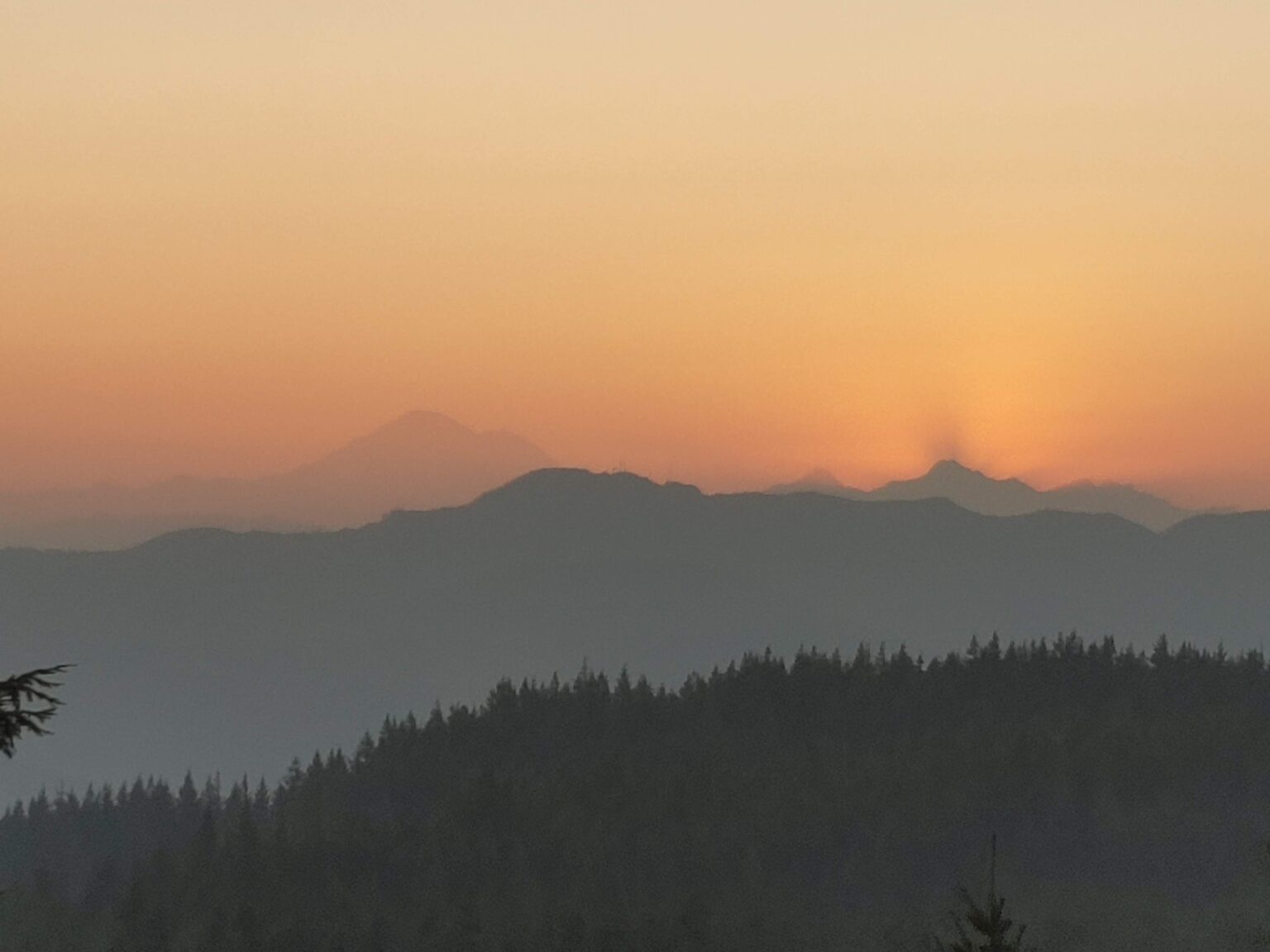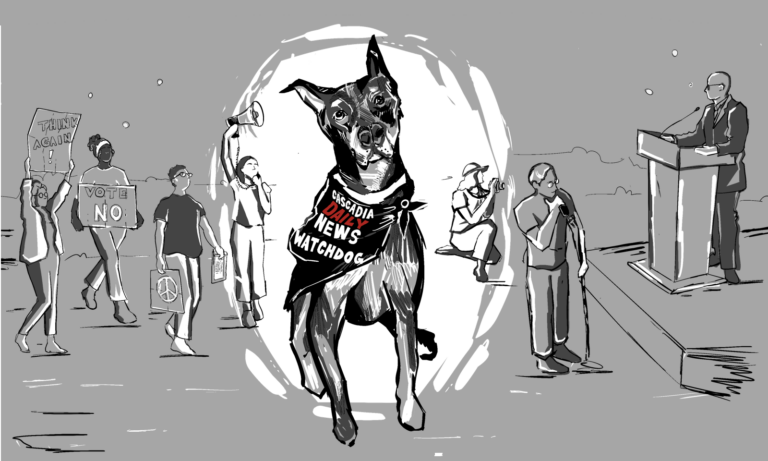Bellingham Fire Chief Bill Hewett, who has worked in fire for 35 years in Whatcom County, remembers when foresters in the Cascades still called the dark, wet groves of the western slope “asbestos forests” because they seemed impossible to ignite.
But climate change has led to longer, drier, hotter summers, warmer winters and less snowmelt, while human development has steadily encroached further into natural spaces, creating a wildland-urban interface, or WUI, that’s more susceptible to fire.
“Some fire is good, when it’s thinning out the forest in far-out, safe locations, but more structures create more risk,” Hewett said.
The devastating fires in urban areas of Los Angeles in January, and the lightning-caused fire on Lake Whatcom that spooked residents and led to an evacuation notice in late summer 2023, are a reminder of the need to plan and prepare for the possibility of fire in our backyards.
Cascadia Daily News reported in August 2023 that Whatcom County was lagging behind its neighbors in wildfire planning — specifically, the county doesn’t have a Community Wildfire Protection Plan (CWPP), a document first adopted by Skagit County in 2009 and San Juan County in 2012. Jefferson County completed its CWPP in 2024, and Snohomish County officials, roused to action by the severe 2022 fire season, started the countywide process in 2024.
The Whatcom County Natural Hazards Mitigation Plan does include a section on wildland fire and the county adopted a wildland fire-specific action plan in November 2023. But Whatcom County is still “continuing to work on developing a CWPP,” according to the county Division of Emergency Management.
“There has been a concerted effort to get the ball rolling, with a lot of internal preliminary work and loosely agenda-ed meetings,” said Robert Walters, the Community Wildfire Resilience specialist for Whatcom and Skagit Conservation Districts.
A CWPP is developed by residents, local government, and state and federal agencies to identify high-risk areas and address wildfire response, evacuation, hazard mitigation, preparedness and structure protection.
Kirk Troberg, the Regional Community Wildfire Resilience coordinator for the state Department of Natural Resources, said a CWPP means the county, its partners and the public are acknowledging the need to prepare for wildfire in a process driven by local values and specifics.
“For most Western Washington counties, wildfire was just not particularly high on the list of priorities in the past,” Troberg wrote in an email to CDN.
Drafting a CWPP is a long, expensive and resource-intensive process, he added. Motivated individuals are often the driving force — for instance, in San Juan County, part-time residents from more fire-prone regions wanted a substantive protection plan in place for the island communities. Sometimes it takes a fire close to home to spark change. Some of the impetus for Skagit County’s initial plan were two wildland fires in 2007, one on Fidalgo Island and one near Concrete.
While Skagit drafted its first plan in 2009, the document wasn’t part of the county’s natural hazard mitigation plan, and “it wasn’t based in science,” explained retired forester Al Craney.
During a CWPP revision a decade later, the project team scrapped most of the 2009 plan and incorporated modern concepts and science.
Craney worked for Skagit Conservation District at the time and helped lead the 2019 update. He was galvanized to act after assisting Okanogan County with recovery from the massive Carlton Complex Fire in the Methow Valley in 2014. FEMA drew ire in the region when the agency denied aid to people impacted by the catastrophe.
The prospect of Skagit County someday losing out on emergency aid prompted Craney to push for the complete revision of the CWPP, to ensure it was in full compliance with FEMA’s requirements. He waited to retire until the project made it over the finish line.
The U.S. Forest Service has guidelines for CWPPs, but the nuts and bolts are left up to the local groups coordinating the effort. The USFS does have a Community Wildfire Defense Grant program to help fund CWPPs, and Whatcom County is applying for a grant.
However, as the Seattle Times reported on Feb. 7, those grants may be in jeopardy with President Trump’s order to freeze funding from the Bipartisan Infrastructure Law. On Feb. 11, U.S. Sen. Patty Murray (D-WA), along with other legislators, criticized Trump for halting funds for forest management and restoration projects, and the universal hiring freeze for Department of Agriculture personnel, which include federal firefighters.
“[A]ddressing the threat of wildfire — even in winter months — should remain a top priority for the Forest Service and the Department of Agriculture,” the senators wrote.
As Whatcom County begins work on its first CWPP, Skagit County will again be reviewing its own plan. Walters and the Skagit Conservation District will take the lead on that process.
“It will be neat to see the differences and similarities between the two,” Walters said. “They should be different, because they’re each a product of the community.”
While a CWPP is important, the local Conservation District’s main focus is education and assistance for communities and landowners.
In 2024 WCD performed 84 free, nonregulatory home risk assessments in Whatcom and 33 in Skagit, and to date has helped eight Whatcom neighborhoods achieve Firewise designation, meaning neighbors have made wildfire preparedness plans and taken steps to reduce their risk, like creating defensible space and installing fire-resistant landscaping.
“We’re always hoping to get more Firewise neighborhoods. It’s a great framework for neighbors and communities to come together and mitigate their risk,” Walters said. “Your house can survive a wildfire — science and real life have proven it.”
Craney’s experience as a firefighter and forester showed him the need for preparedness in the face of intense, hard-to-manage fires, like the ones in Los Angeles in January.
“When you have a fire with that kind of wind, you can’t stop it,” Craney said. “The only chance you’ve got is to prepare ahead of time.”
Still no fire plan for the arboretum
One wildland-urban interface that has received extra attention is the Sehome Hill Arboretum, the 175-acre forested hill in the heart of Bellingham. Soon after CDN reported in August 2023 that the city and Western Washington University had no fire action plan for the arboretum, an intergovernmental group met to discuss the development of one, and is expecting follow-up meetings in 2025, city parks director Nicole Oliver said in January.

Fuel reduction work has not been undertaken in the arboretum, where an illegal campfire or engine spark on a dry, windy day could mean a fast-growing fire. The park is surrounded by dense residential and institutional development on all sides.
According to a 2021 WUI report commissioned by the city as part of the Urban Forestry Management Plan, the arboretum has a medium level of fuel-loading risk, consistent with most urban forests in the city. The study says the arboretum is made up of healthy stands with sparse undergrowth and a thin layer of ground fuels. Fire behavior can be dangerous in this kind of forest but typically only in extreme fire weather.
The arboretum’s landscape isn’t unusual in Bellingham. The city has several large, forested parks, and the Bellingham Fire Department has the same constraints when it comes to fighting any wildland fire — the department is equipped to fight urban structure fires.

With standard fire engines, firefighters can’t access the top of Arboretum Drive or some other forested areas like the Samish Crest, although fortunately, many of the city’s greenways are wide enough to drive an engine on. Focused on protecting lives and structures, BFD firefighters do not perform wildland activities like digging fire lines or felling trees. But the department does have agreements in place with South Whatcom Fire Authority and North Whatcom Fire & Rescue as well as DNR, all of which have wildland brush trucks and are equipped and trained to fight wildland fires.
BFD Chief Bill Hewett said the department is adapting in anticipation of more wildfires in the future. In 2024 the city ordered lightweight wildland personal protective equipment to complement heavy-duty structural firefighting gear, so responders on foot can be more mobile. The department also partners with the city public works department on fire planning and resilience for city-owned conservation properties in the Lake Whatcom watershed.
“That’s one of the greatest parts of the City of Bellingham — that the community has prioritized protecting urban forests and open space,” Hewett said. “But we’re definitely engaged in ongoing conversations about our wildland capabilities throughout our service area. As a department, we’re always evolving.”
Julia Tellman writes about civic issues and anything else that happens to cross her desk; contact her at juliatellman@cascadiadaily.com.




